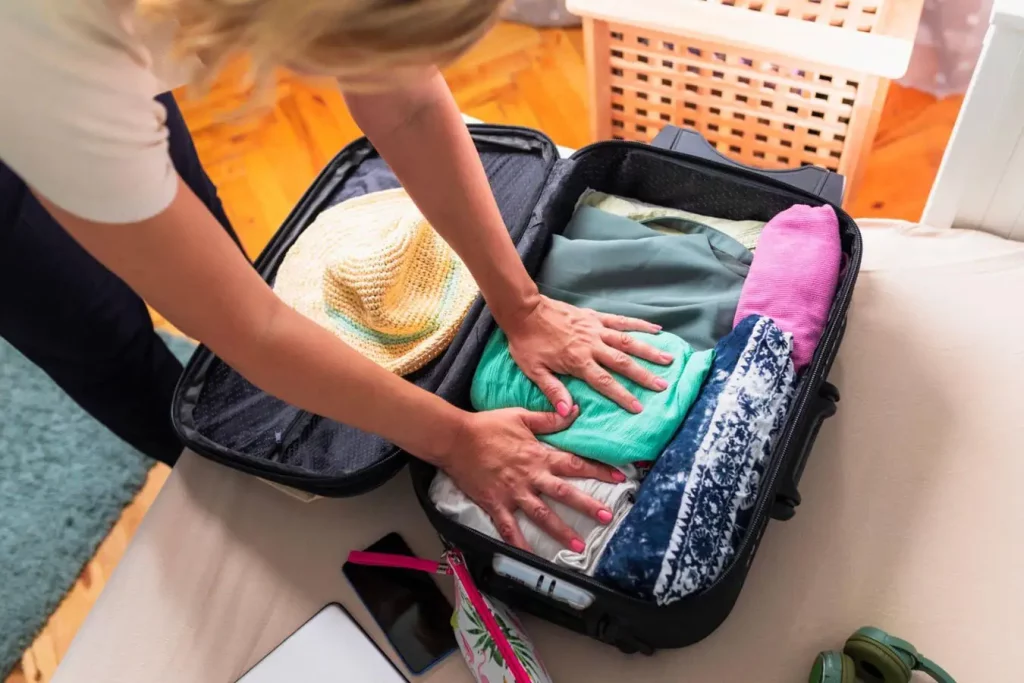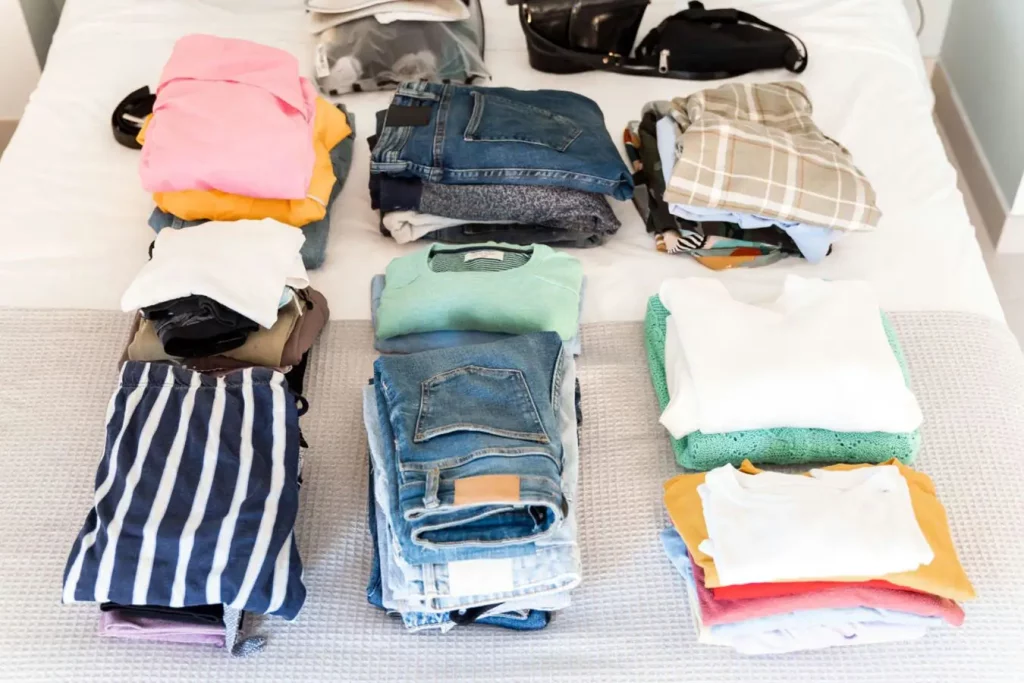Struggling with how to fold clothes for travel backpack on your next outdoor adventure?
I know the feeling – packing can be a real headache!
Learn how to do it yourself.
The Importance of Efficiently Folding Clothes for Travel
Organizing your clothing for travel well has a number of advantages. First of all, it enables you to make the most of the space in your bag, allowing you to load more things without going over weight restrictions. Second, well-organized folding prevents needless creases, saving you time and work when you arrive.
Essential Items for Folding Clothes
Before you begin folding your clothes, gather a few essential items that will make the process easier. These include:
- Hangers or folding board: These aids will help you achieve uniform folds and keep your clothes wrinkle-free.
- Garment bag or packing cubes: These are useful for organizing and separating different types of clothing items.
- Lint roller or brush: Useful for removing any lint or dust particles from your clothes before folding.
- Iron or steamer: If you encounter stubborn wrinkles, having an iron or steamer on hand will help you smooth them out.
Guide on How to Fold Clothes for Travel Backpack
1. Preparing Your Clothes
Before folding, it’s important to prepare your clothes. Make sure they are clean and dry to avoid any unpleasant odors or stains during your travels. Remove any accessories or detachable parts that might get tangled or damaged in transit. Sorting your clothes by type or category can help streamline the folding process and keep you organized throughout your journey.
2. Folding Techniques for Tops and Shirts
To fold tops and shirts, lay them flat on a clean surface. Smooth out any wrinkles and align the seams and edges. Fold one sleeve towards the center, creating a straight line along the shoulder. Repeat with the other sleeve. Fold the shirt in half lengthwise, aligning the edges. Finally, fold it in half or roll it tightly to save additional space.
3. Folding Techniques for Bottoms and Pants
For bottoms and pants, lay them flat with the front side facing up. Straighten out any wrinkles or creases. Fold one leg towards the center, aligning the edges. Repeat with the other leg. Fold the pants in half lengthwise, ensuring the waistband aligns with the hem. Fold it in half again or roll it tightly.
4. Folding Techniques for Undergarments and Socks
Undergarments and socks can be folded compactly. Lay them flat and fold them in half lengthwise. Roll them tightly into a small bundle, making sure they hold their shape. This technique not only saves space but also helps keep your undergarments organized and easily accessible.
5. Folding Techniques for Dresses and Skirts
Dresses and skirts can be trickier to fold due to their length and delicate fabrics. Lay them flat, facing down, and smooth out any wrinkles. Fold the garment in half lengthwise, aligning the edges. If the dress or skirt is particularly long, you can fold it again to create a more compact size. Remember to handle these items with care to avoid unnecessary wrinkles or damage.
6. Folding Techniques for Sweaters and Jackets
Sweaters and jackets require a slightly different folding approach to prevent wrinkles and preserve their shape. Lay the garment flat, facing up, and smooth out any wrinkles. Fold the arms towards the back, creating a straight line along the shoulder seams. Fold the sweater or jacket in half lengthwise, aligning the edges. If needed, fold it again or roll it tightly to save space.
7. Folding Undergarments and Socks
For undergarments and socks, fold them into compact squares or rectangles. Start by folding them in half, then in half again, until you achieve a small and uniform shape. This folding technique allows you to stack multiple items neatly together.
Packing Strategies for Maximizing Space in Your Travel Backpack
1. Rolling vs. Folding
When it comes to packing clothes in your travel backpack, you have the option of rolling or folding them. Rolling clothes can save space and prevent wrinkles, especially for items made of wrinkle-resistant fabrics. However, folding clothes allows for easier organization and access to specific items. It’s recommended to use a combination of both techniques depending on the type of clothing and available space in your backpack.

2. Utilizing Packing Cubes or Compression Bags
Packing cubes or compression bags can be invaluable for maximizing space and keeping your clothes organized. These accessories allow you to compartmentalize your belongings, making it easier to find specific items without unpacking everything. Compression bags also help reduce the overall volume of your clothes, providing extra space for other essentials.
3. Utilizing Empty Spaces and Layers
To make the most of the available space, utilize empty spaces within your backpack. Fill shoes or gaps between larger items with rolled socks or small clothing items. Layer your clothes strategically, starting with heavier or bulkier items at the bottom and lighter ones on top. This method helps distribute the weight evenly and prevents your backpack from becoming top-heavy.
>> How To Pack A Backpack For Air Travel
Tips for Maximizing Space and Reducing Wrinkles
To maximize space and reduce wrinkles while folding clothes for your travel backpack, keep the following tips in mind:
- Roll socks and undergarments to fill gaps and utilize space effectively.
- Place heavier items at the bottom of your backpack to distribute weight evenly.
- Use packing cubes or compression bags to further compress and organize folded clothes.
- Avoid overpacking by sticking to essential items and versatile clothing pieces.
- Utilize the space inside shoes by stuffing them with socks or small accessories.
- Pack a small, travel-sized wrinkle-releasing spray to refresh clothes if needed.
Additional Tips for Organizing and Packing Your Travel Backpack
1. Categorizing and Segregating Clothes
Organize your clothes by type or category to facilitate easier unpacking and access. Use separate packing cubes or bags for different clothing items, such as tops, bottoms, undergarments, and accessories. Categorizing your clothes allows you to quickly locate what you need without disrupting the entire contents of your backpack.
2. Utilizing Ziplock Bags for Toiletries and Small Items
Toiletries and small items can easily become disorganized and leak within your backpack. Use ziplock bags to store toiletries, preventing any spillage or damage to your clothes. Additionally, these bags are useful for organizing smaller items such as chargers, adapters, or jewelry, ensuring everything is easily accessible and protected.
3. Utilizing Packing Accessories and Hacks
Consider using packing accessories such as packing cubes, garment folders, or packing envelopes for documents. These tools help optimize space and keep your belongings neat and tidy. Additionally, employing packing hacks like stuffing socks or underwear inside shoes or using rubber bands to secure rolled garments can further save space and maintain organization.
FAQs
Should I fold or roll my clothes for a travel backpack?
How can I prevent my clothes from wrinkling in a travel backpack?
Can I fit bulky sweaters or jackets in a travel backpack?
Are there any packing accessories that can help with organizing clothes?
How can I make the most of the available space in my travel backpack?
To sum it up
Efficiently folding clothes for your travel backpack is a skill that can greatly enhance your travel experience. By following the step-by-step instructions and techniques outlined in this article, you can maximize space, keep your clothes organized, and reduce wrinkles.
Remember to sort and group similar clothing items, remove wrinkles before folding, utilize specific folding techniques for each garment type, and organize your folded clothes in your backpack strategically. With these tips, you’ll be ready for an organized and stress-free journey. Happy travels!


